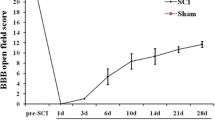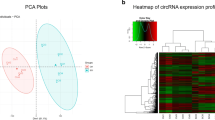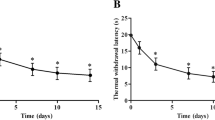Summary
The spinal origin of cholestatic itch in experimental obstructive jaundice mouse model remains poorly understood. In this study, the jaundice model was established by bile duct ligation (BDL) in mice, and differential gene expression patterns were analyzed in the lower thoracic spinal cord involved in cholestatic pruritus after BDL operation using high-throughput RNA sequencing. At 21st day after BDL, the expression levels of ENSRNOG00000060523, ENSRNOG00000058405 and ENSRNOG00000055193 mRNA were significantly up-regulated, and those of ENSRNOG00000042197, ENSRNOG00000008478, ENSRNOGOOOOOO19607, ENSRNOG00000020647, ENSRNOG00000046289, Gemin8, Serpina3n and Trim63 mRNA were significantly down-regulated in BDL group. The RNAseq data of selected mRNAs were validated by RT-qPCR. The expression levels of ENSRNOG00000042197, ENSRNOG00000008478, ENSRNOGOOOOOO 19607, ENSRNOG00000020647, ENSRNOG00000046289 and Serpina3n mRNA were significantly down-regulated in BDL group. This study suggested that cholestatic pruritus in experimental obstructive jaundice mouse model is related with in the changes of gene expression profiles in spinal cord.
Similar content being viewed by others
References
Mittal A. Cholestatic itch management. Curr Problems Dermatol, 2016, 50(1):142–148
Belghiti M, Estevez-Herrera J, Gimenez-Garzo C, et al. Potentiation of the transient receptor potential vanilloid 1 channel contributes to pruritogenesis in a rat model of liver disease. J Biol Chem, 2013, 88(14):9675–9685
Dawson PA, Karpen SJ. Bile acids reach out to the spinal cord: New insights to the pathogenesis of itch and analgesia in cholestatic liver disease. Hepatology, 2014, 59(4):1638–1641
Alemi F, Kwon E, Poole DP, et al. The tgr5 receptor mediates bile acid-induced itch and analgesia. J Clin Invest, 2013, 123(4):1513–1530
Wang Q, Li ZX, Liu BW, et al. Altered expression of differential gene and IncRNA in the lower thoracic spinal cord on different time courses of experimental obstructive jaundice model accompanied with altered peripheral nociception in rats. Oncotarget, 2017, 8(62):106 098–10 6112
Hasanein P, Parviz M. Role of GABAA receptor in modulation of acute thermal pain using a rat model of cholestasis. Pharmacol Biochem Behav, 2014, 124(1):226–230
Ahmadi S, Poureidi M, Rostamzadeh J. Hepatic encephalopathy induces site-specific changes in gene expression of GluNl subunit of NMDA receptor in rat brain. Metab Brain Dis, 2015, 30(4):1035–1041
Tag CG, Sauer-Lehnen S, Weiskirchen S, et al. Bile duct ligation in mice: Induction of inflammatory liver injury and fibrosis by obstructive cholestasis. J visualized Exp, 2015, 96. doi:10.3791/52438
Lee E. The effect of obstructive jaundice on the migration of reticulo-endothelial cells and fibroblasts into early experimental granulomata. Br J Surg, 1972, 59(11):875–877
Ahmadi S, Karami Z, Mohammadian A, et al. Cholestasis induced antinociception and decreased gene expression of MORI in rat brain. Neuroscience, 2015, 284:78–86
Song Y, Pan X, Liu C, et al. Role of nociceptive arcuate nucleus neurons in chloroquine-induced pruritic behaviors in mice. J Huazhong Univ Sci Technolog Med Sci, 2012, 32(6):919–922
Liu C, Liu TT, He ZG, et al. Inhibition of itch-related responses by selectively ablated serotonergic signals at the rostral ventromedial medulla in mice. Int J Clin Exp Pathol, 2014, 7(12):8917–8921
He ZG, Liu BW, Li ZX, et al. Altered expression profiling of spinal genes modulated by compound 48/80 in a mouse itch model. J Anesth Perioperat Med, 2017, 4(6):220–224
Liu BW, Li ZX, He ZG, et al. Altered expression of target genes of spinal cord in different itch models compared with capsaicin assessed by RT-qPCR validation. Oncotarget, 2017, 8(43):74423–74433
Liu T, He Z, Tian X, et al. Specific patterns of spinal metabolites underlying alpha-Me-5-HTevoked pruritus compared with histamine and capsaicin assessed by proton nuclear magnetic resonance spectroscopy. Biochim Biophys Acta, 2017, 1863(6):1222–1230
Zhu B, Xu M, Shi H, et al. Genome-wide identification of IncRNAs associated with chlorantraniliprole resistance in diamondback moth plutella xylostella (L.). BMC Genomics, 2017, 18(1):380
Li D, Ji Y, Wang F, et al. Regulation of crucial IncRNAs in differentiation of chicken embryonic stem cells to spermatogonia stem cells. Anim Genet, 2017, 48(2):191–204
Wang CY, Liu SR, Zhang XY, et al Genome-wide screening and characterization of long non-coding RNAs involved in flowering development of trifoliate orange (poncirus trifoliata 1. Raf.). Sci Rep, 2017, 7(3):43 226
Ke C, Gao F, Tian X, et al. Slit2/robol mediation of synaptic plasticity contributes to bone cancer pain. Mol Neurobiol, 2017, 54(1):295–307
Guan XH, Fu QC, Shi D, et al. Activation of spinal chemokine receptor CXCR3 mediates bone cancer pain through an AKT-ERK crosstalk pathway in rats. Exp Neurol, 2015, 263(1):39–49
Bu H, Shu B, Gao F, et al Spinal IFN-y-induced protein-10 (CXCL10) mediates metastatic breast cancer-induced bone pain by activation of microglia in rat models. Breast Cancer Res Treat, 2014, 143(2):255–263
Xu B, Guan XH, Yu XX, et al. Activation of spinal phosphatidylinositol 3-kinase/protein kinase B mediates pain behavior induced by plantar incision in mice. Exp Neurol, 2014, 255(1):71–82
Fu Q, Shi D, Zhou Y, et al. MHC-I promotes apoptosis of GAB Aergic interneurons in the spinal dorsal horn and contributes to cancer induced bone pain. Exp Neurol, 2016, 286(1):12–20
Ren HM, Yang LQ, Liu ZQ, et al. In vivo and ex vivo effects of propofol on myocardial performance in rats with obstructive jaundice. BMC Gastroenterol, 2011, 11(1):144
Lee SS, Pak JM, Medlicott SM, et al Vasodilatory responses of isolated arteries of cirrhotic rats. Clin Sci (Lond), 1995, 89(3):227–232
Hasanein P, Parviz M, Keshavarz M, et al. Modulation of cholestasis-induced antinociception in rats by two NMDA receptor antagonists: MK-801 and magnesium sulfate. Eur J Pharmacol, 2007, 554(2–3):123–127
Rastegar H, Homayoun H, Afifi M, et al. Modulation of cholestasis-induced antinociception by cck receptor agonists and antagonists. Eur Neuropsychopharmacol, 2002, 12(2):111–118
Nelson L, Vergnolle N, D’Mello C, et al. Endogenous opioid-mediated antinociception in cholestatic mice is peripherally, not centrally, mediated. J Hepatol, 2006, 44(6):1141–1149
Lieu T, Jayaweera G, Zhao P, et al. The bile acid receptor TGR5 activates the trpal channel to induce itch in mice. Gastroenterology, 2014, 147(6):1417–1428
de Aguiar Valiim TQ, Tarling EJ, Edwards PA. Pleiotropic roles of bile acids in metabolism. Cell Metab, 2013, 17(5):657–669
Author information
Authors and Affiliations
Corresponding author
Additional information
This project was supported by grants from Health and Family Planning Commission in Hubei Province Scientific Research Project (No. WJ2017M131) and Medical Training Programme Foundation for Mid-Youth Key Scholars in Wuhan (No. 2017-9).
Rights and permissions
About this article
Cite this article
Chen, M., Li, Zx., Wang, Q. et al. Altered Expression of Differential Genes in Thoracic Spinal Cord Involved in Experimental Cholestatic Itch Mouse Model. CURR MED SCI 38, 679–683 (2018). https://doi.org/10.1007/s11596-018-1930-1
Received:
Revised:
Published:
Issue Date:
DOI: https://doi.org/10.1007/s11596-018-1930-1




